ATR has established itself in the field of information technology (IT) as a center of excellence among international scientific communities. Correspondingly there are greater expectations that ATR should produce more practical outputs of research discoveries and related information. Its international and inter-disciplinary approach to promoting advancing research is paving the way for IT to contribute even more to society in a variety of forms. As IT research enters a phase of mature stability, there is strong anticipation for ATR to further define its role vis-a-vis R&D among universities, national institutes and private enterprises, so that it can share responsibilities, collaborate, and compete with them. To achieve this, it needs to unite itself in the pursuit of common R&D strategies and to send out more concentrated information for others to share. I strongly believe that ATR should set solid goals for the overall organization, rather than to allow each researcher or group to follow individual R&D strategies. ATR needs to align the course of R&D within the groups, set systematic goals of a greater magnitude through cooperation among the groups, and place the focus on project activities backed by the institute as a whole.
Society is constantly seeking to create new concepts and further implement these concepts with high-level fundamental technologies. It is becoming increasingly important for ATR to present the society with the fruits of its system concepts and state-of-the-art technology developments in terms of beneficiary services. Since media technology has now entered the stream of daily life, ATR needs to research, develop, test, and improve its technologies to ensure that they can be of maximum advantage to the society.
Information media is progressing in parallel with its associated hardware, which requires further pursuing of technology directions in it both hardware wise and software wise and set a proactive course for R&D. We must then pursue that course in a competitive research environment and provide the outcome to society. For example, there is a technical shift towards greater compactness, higher speed, and larger-capacity IT devices, which is creating a host of new wearable and/or ubiquitous IT applications. The information to be manipulated is growing from numerical data and linguistic information to a variety of sensory information, including acoustic, imaginary, and other multimedia forms. This information is destined to become a natural part of our daily lives. We are approaching a world of advanced IT at a greater speed than many anticipated. Examples of this progress include the shift from one-way broadcasting to two-way communications featuring interactivity between people and systems, from single-point to multipoint communications, the use of embodied forms of media as in domestic application robots, and the use of Internet-based media holding a massive amount of multimedia information. The ability to catch up with and outpace this speed of social transformation is essential to the survival of any research institute that aims to create new information media and environments. Research institutes will do well to keep these social trends in mind rather than simply seeking new technological frontiers.
We may also be facing new evaluation criteria for technology in the digital world as we shift from engineering in an industrial society, where efficiency comes first, to engineering in a knowledge society. Here, we need to make sure that all outcomes are optimized and that new creations are born, so that we can put them to use in society at large and in the daily lives of all. We hope to introduce a set of new evaluation criteria for assessing such parameters as healing, entertainment, and comfort, and to create a new style of IT for use in everyday lives. We expect to find new uses for always-on information media by taking into consideration the entire IT range -- from conscious to unconscious daily behavior. We aim to distinguish among application system functions as extensions or substitutions of our information activity functions. In this kind of R&D domain, we will always be reminded of the need to proactively support and augment ourselves so as not to hinder the development of our inherent information activity functions. Since technological progress is a source of both shadow and light for all of the researchers in ATR and Kansai Science City, we must press forward with it in a positive and energetic manner to ensure a bright future and continued good relations with the real world.
The research institutes and engineers of Kansai Science City are characterized by their innovation, talents, inherent diversity and multiple cultures. These are the same characteristics that allow our R&D activities to successfully merge into a positive feedback cycle. National research institutes and private enterprise research teams are expected to create leading-edge concepts for IT applications and to show their attractiveness to society. Surrounding business organizations, such as venture companies, small-business federations, and large enterprises, then step in to help them grow. Similar to America's Silicon Valley, we should unite our efforts in this science community to produce new media technologies, put them to effective use, and then work hand-in-hand with related businesses to keep the flow of capital moving in a healthy, mutually rewarding cycle. I would like to see ATR take the lead in building a cooperative framework among these organizations.


